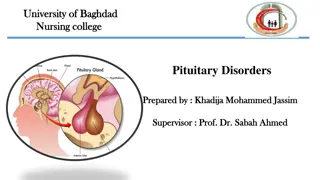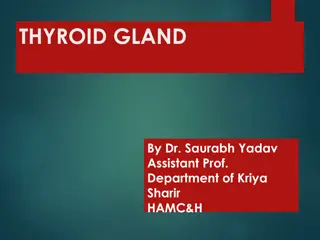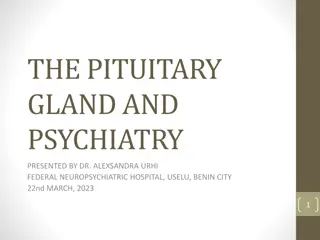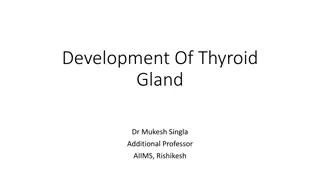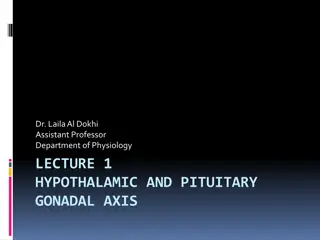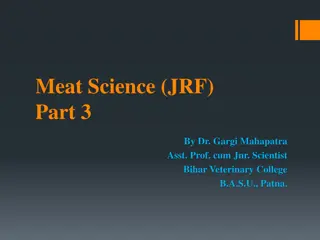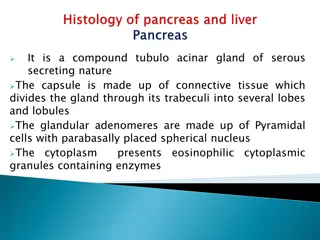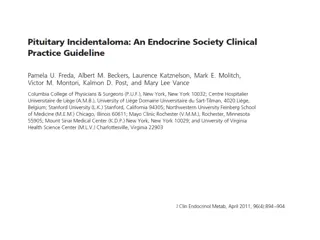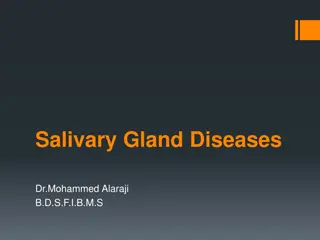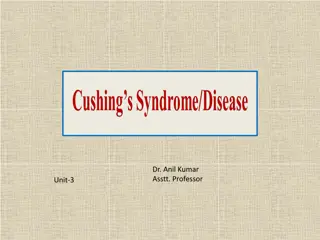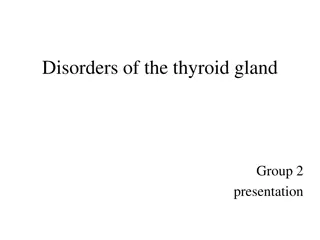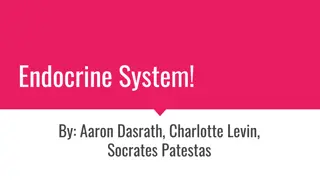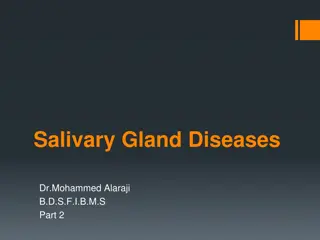Understanding the Pituitary Gland: Anatomy, Functions, and Disorders
The pituitary gland, also known as the master endocrine gland, plays a crucial role in regulating various hormonal functions in the body. Learn about its anatomy, position, subdivisions, important relations, and common disturbances. Explore how soldiers and individuals like them can be affected by pituitary gland disorders.
Download Presentation

Please find below an Image/Link to download the presentation.
The content on the website is provided AS IS for your information and personal use only. It may not be sold, licensed, or shared on other websites without obtaining consent from the author. Download presentation by click this link. If you encounter any issues during the download, it is possible that the publisher has removed the file from their server.
E N D
Presentation Transcript
ANATOMY OF THE PITUITARY GLAND 2 Who suffer (s) from pituitary disturbances? 1) Soldier # 1 2) Soldier # 2 3) Soldier # 3 4) Soldiers # 1 & 3 1 3 Dr. Ahmed Fathalla Ibrahim
OBJECTIVES At the end of the lecture, students should be able to: Describe the position of the pituitary gland. List the structures related to the pituitary gland. Differentiate between the lobes of the gland. Describe the blood supply of pituitary gland & the hypophyseal portal system.
PITUITARY GLAND (HYPOPHYSIS CEREBRI) It is referred to as the master of endocrine gland. It is a small oval structure of 1 cm in diameter. It doubles its size during pregnancy.
PITUITARY GLAND (POSITION) Optic chiasma Mammillary body Body of sphenoid It lies in the hypophyseal fossa of the body of sphenoid bone, between optic chiasma (anteriorly) & mamillary bodies (posteriorly).
PITUITARY GLAND (POSITION) It is well protected in sella turcica of body of sphenoid It lies in the middle cranial fossa Sella turcica
PITUITARY GLAND (POSITION) Infundibulum A fold of dura mater (Diaphragma sellae) covers the pituitary gland & has an opening for passage of infundibulum (pituitary stalk) connecting the gland to hypothalamus.
PITUITARY GLAND X-RAY SKULL: LATERAL VIEW SAGITTAL SECTION OF HEAD & NECK Pituitary gland Hypophyseal fossa Sphenoidal air sinus
IMPORTANT RELATIONS SUPERIOR: Diaphragma sellae INFERIOR: Sphenoidal air sinuses LATERAL: Cavernous sinuses
SUBDIVISIONS OF PITUITARY GLAND Hypothalamo Hypothalamo- -hypophyseal tract tract hypophyseal The gland is subdivided into: 1) Anterior lobe (adenohypophysis): true gland, secretes hormones 2) Posterior lobe (neurohypophysis): connected to hypothalamus through hypothalamo-hypophyseal tract, stores hormones secreted by hypothalamic nuclei
BLOOD SUPPLY OF PITUITARY GLAND Cavernous sinuses ARTERIES: Superior & inferior hypophyseal arteries (branches of internal carotid artery) VEINS: hypophyseal veins drain into cavernous sinuses.
ARTERIES OF PITUITARY GLAND Infundibulum a hypothalamo- hypophseal portal vessel The inferior hypophyseal: supplies posterior lobe of pituitary gland. The superior hypophyseal: supplies infundibulum & forms a capillary network from which vessels pass downward & form sinusoids into the anterior lobe of pituitary gland (hypophyseal portal system).
ANTERIOR LOBE OF PITUITARY Hormone-releasing & inhibiting factors produced by hypothalamus use hypophyseal portal system of vessels to reach the anterior lobe of pituitary gland Hypophyseal portal system
POSTERIOR LOBE OF PITUITARY Axons of supraoptic & paraventricular cells of hypothalamus send their secretion (neurosecretion) to posterior lobe of pituitary gland through hypothalamo- hypophyseal tract Hypothalamo- hypophyseal tract
QUESTIONS QUESTIONS
QUESTION 1 Which one of the following structures is superior to the pituitary gland? 1) Optic chiasma 2) Diaphragma sellae 3) Mammillary bodies 4) Sphenoidal air sinuses
QUESTION 2 Which one of the following venous sinuses drains hypophyseal veins? 1) Superior sagittal 2) Cavernous 3) Transverse 4) Sigmoid
THANK YOU THANK YOU & & BEST WISHES BEST WISHES


